The following examples are shipped with the Xtext framework and are available from the Xtext Example Wizard. They are extended by Model-to-Text transformations to generate intermediate Graphviz *.dot files as inputs for the GEF DOT Graph View.
Visualizing the Xtext Domain-Model Example
The Xtext Domain-Model Example describes a language that allows the specification of entities with their properties/operations and their relations to each other.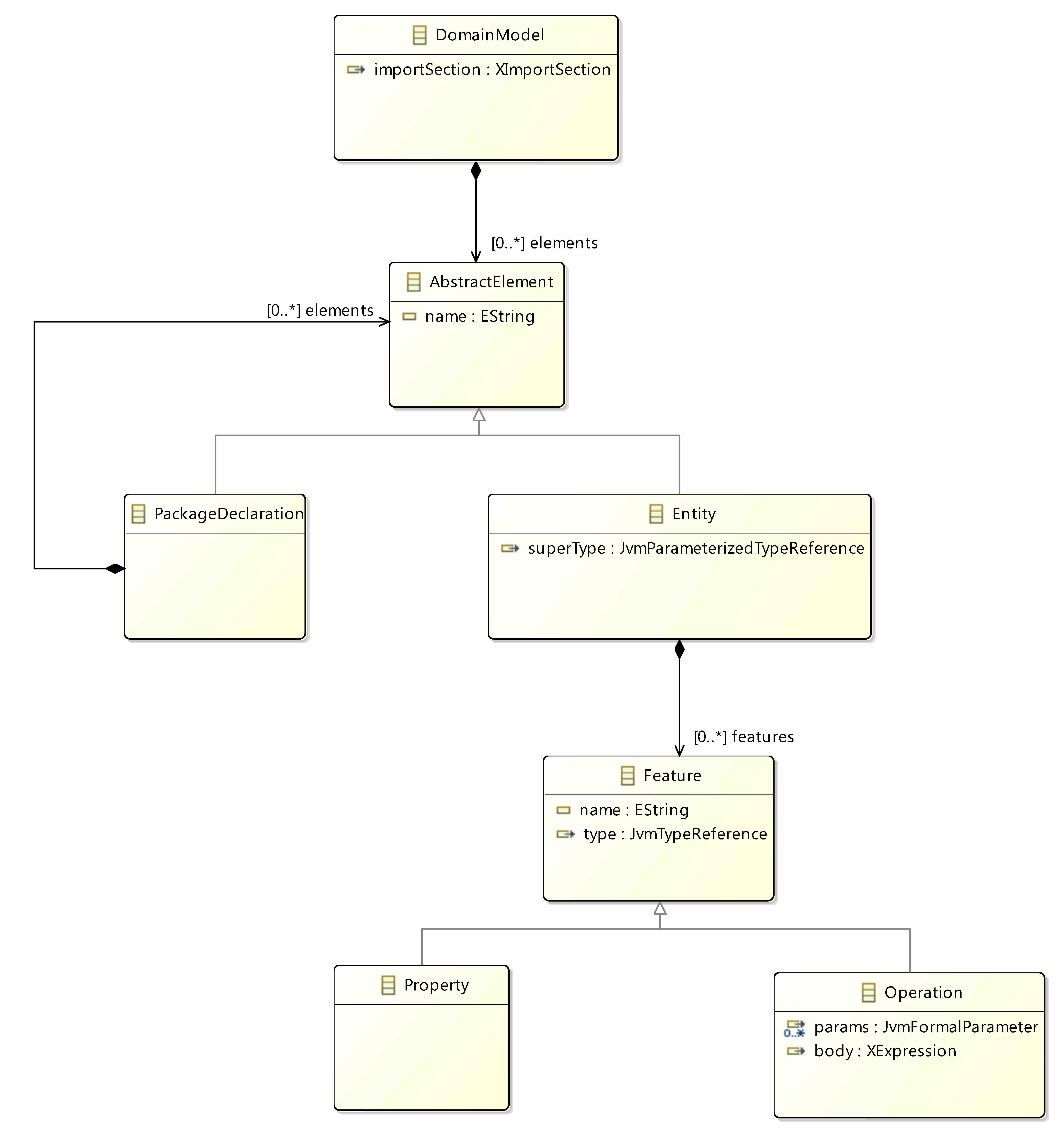
The DomainmodelDotGeneratorTest test suite specifies how the different Entity DSLs should be translated to Graphviz DOT files.
@RunWith(XtextRunner)
@InjectWith(DomainmodelInjectorProvider)
class DomainmodelDotGeneratorTest {
...
@Test def test13() {
'''
import java.util.List
entity Blog {
title: String
posts: List<Post>
op addPost(Post post) : void { }
op getPosts() : List<Post> {}
}
entity HasAuthor {
author: String
op getAuthor() { author }
op setAuthor() : void {}
}
entity Post extends HasAuthor {
title: String
content: String
comments: List<Comment>
}
entity Comment extends HasAuthor {
content: String
}
'''.assertCompilesTo('''
digraph {
// layout=sfdp
nodesep=1.2
rankdir=BT
node [shape=record style="filled, bold" color="#CE970D" fillcolor="#FAEAC1" fontcolor="#CE970D"]
// nodes
Blog [
label = "{
Blog|
title : String\l|
addPost(Post post) : void\lgetPosts() : List\<Post\>\l
}"
]
HasAuthor [
label = "{
HasAuthor|
author : String\l|
getAuthor() : String\lsetAuthor() : void\l
}"
]
Post [
label = "{
Post|
title : String\lcontent : String\l|
}"
]
Comment [
label = "{
Comment|
content : String\l|
}"
]
// inheritance edges
edge[arrowhead=onormal color="#CE970D" fontcolor="#CE970D"]
Post -> HasAuthor
Comment -> HasAuthor
// association edges
edge[arrowhead=normal arrowtail=diamond dir=both constraint=false]
Blog -> Post [headlabel="posts\n[0..*]"]
Post -> Comment [headlabel="comments\n[0..*]"]
}
''')
}
...
}
The implementation of the DomainmodelDotGenerator shows that each entity is translated into a DOT node, the entity's properties/operations are coded into the DOT node's record-based label, while the inheritance/association relationships are converted to DOT edges with corresponding arrowhead/arrowtail symbols.
class DomainmodelDotGenerator extends JvmModelGenerator {
...
override void doGenerate(Resource input, IFileSystemAccess fsa) {
fsa.generateFile(input.fileName, (input.contents.head as DomainModel).toDot)
}
def toDot(DomainModel it) '''
digraph {
// layout=sfdp
nodesep=1.2
rankdir=BT
«generateEntities»
«generateInheritanceConnections»
«generateAssociationConnections»
}
'''
private def generateEntities(DomainModel it) '''
node [shape=record style="filled, bold" color="#CE970D" fillcolor="#FAEAC1" fontcolor="#CE970D"]
// nodes
«FOR entity : entities»
«entity.generate»
«ENDFOR»
'''
private def generate(Entity it) '''
«name» [
label = "{
«name»|
«generateProperties»|
«generateOperations»
}"
]
'''
...
private def generateInheritanceConnections(DomainModel it) '''
// inheritance edges
edge[arrowhead=onormal color="#CE970D" fontcolor="#CE970D"]
«FOR entity : entities»
«IF entity.superType!==null»
«entity.name» -> «entity.superType.simpleName»
«ENDIF»
«ENDFOR»
'''
private def generateAssociationConnections(DomainModel it) '''
// association edges
edge[arrowhead=normal arrowtail=diamond dir=both constraint=false]
«FOR entity : entities»
«FOR property : entity.associationProperties»
«entity.name» -> «property.type.determineType.simpleName» [headlabel="«property.associationLabel»"]
«ENDFOR»
«ENDFOR»
'''
...
}
As soon as the Xtext project is extended by the GEF DOT-based visualization support, the Show In -> DOT Graphcontext menu of the Xtext Editor opens the graphical representation of the Xtext DSL.
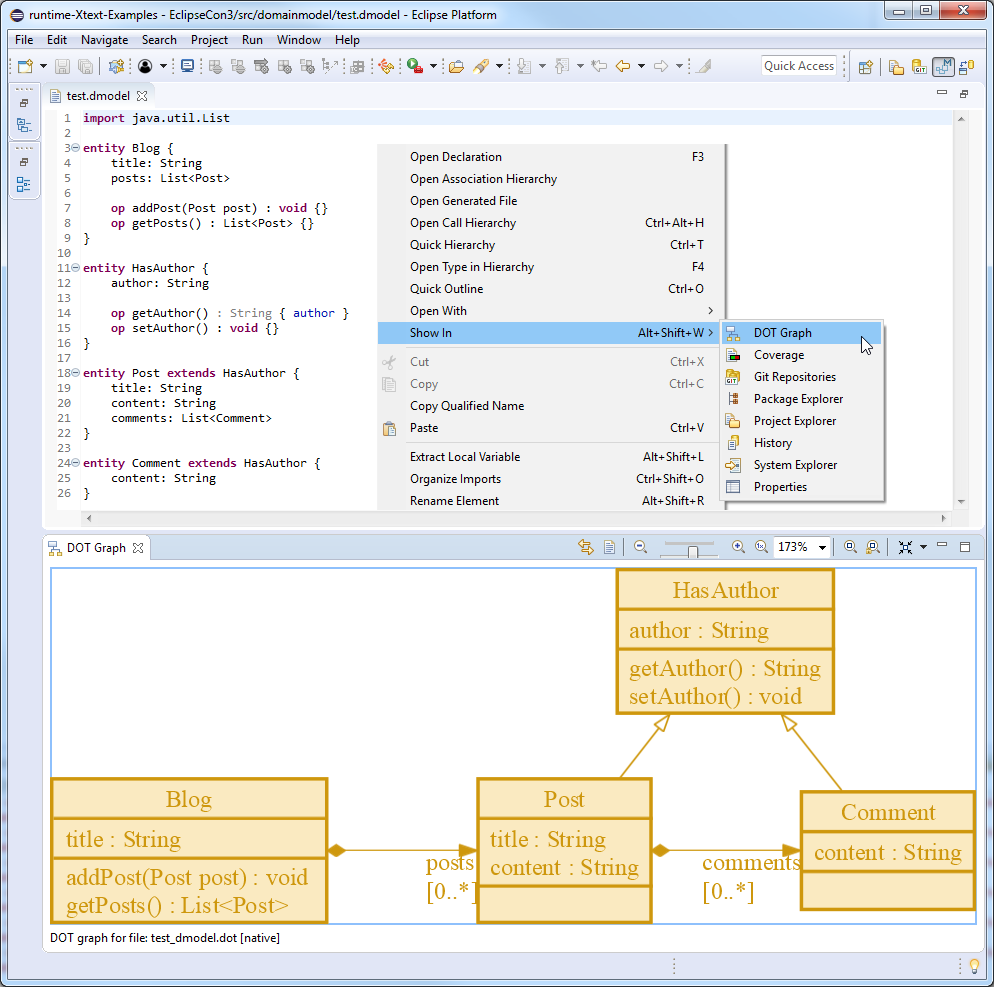
Visualizing the Xtext Home Automation Example
The Xtext Home Automation Example describes a language for home automation systems that allows the specification of devices with their states and rules to describe the effects of the events on the devices' states. 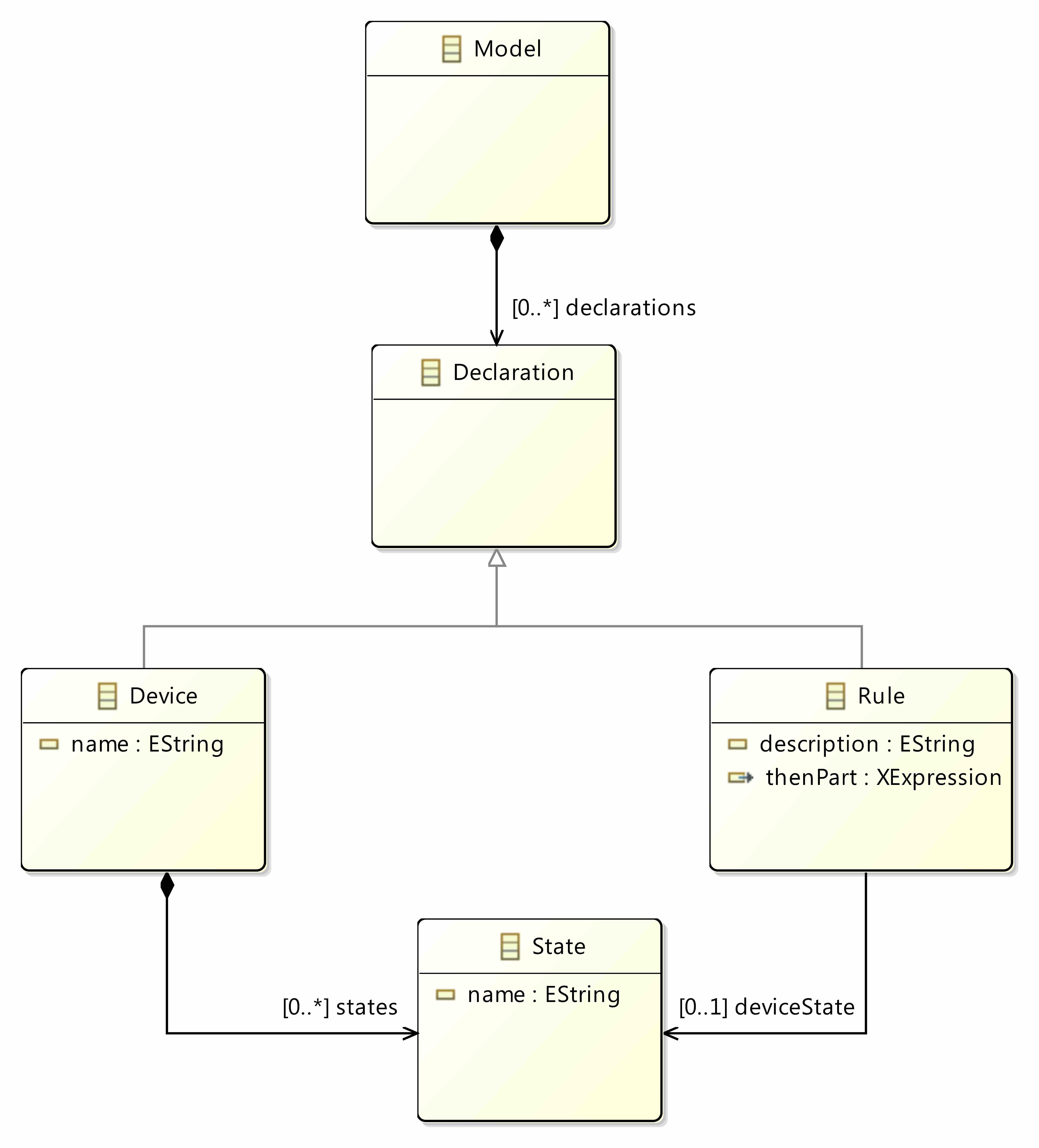
Rules firing the same device state may lead to endless recursion. Such warnings are presented on the textual editor and also on the graphical view.
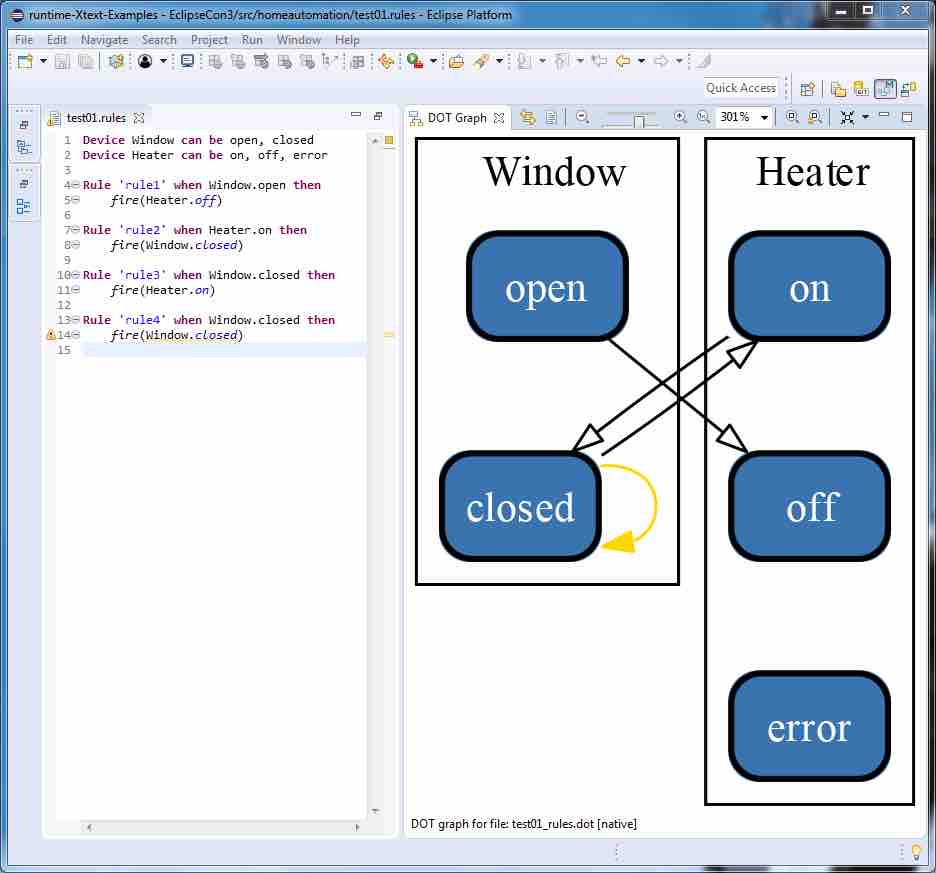
Visualizing the Xtext Simple Arithmetics Example
The Xtext Simple Arithmetics Example describes a language for simple arithmetics calculation such as addition, substraction, multiplication and division. The operands of an expression can either be a simple number, a function call or even a complex expression. 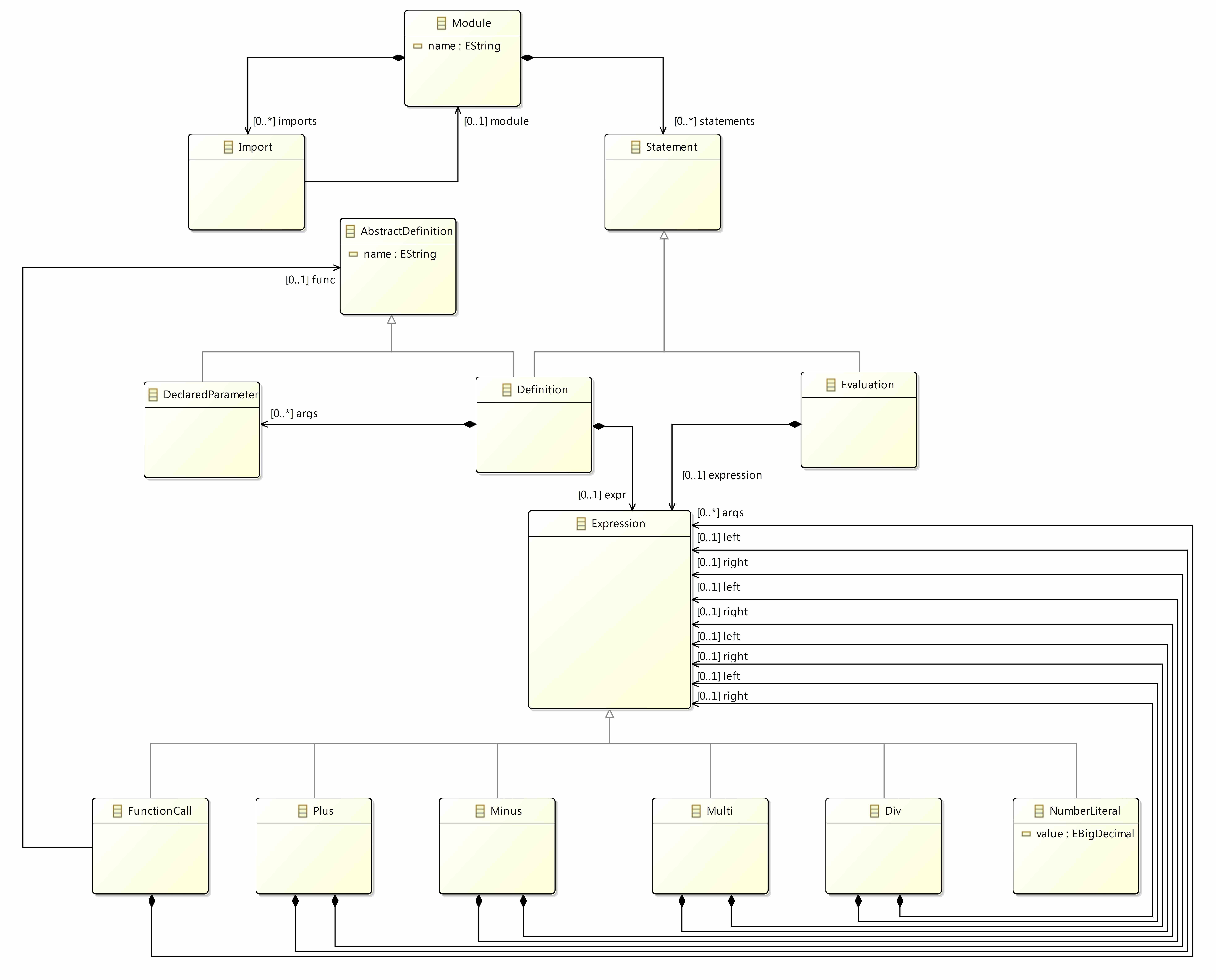
The graphical view on an expression shows not only the operators with their operands, but also the values of each sub-expressions.

Visualizing the Xtext State-Machine Example
The Xtext State-Machine Example describes a languages for State-Machine definitions. A state machine consists of certain commands, events, states and transitions.

On the graphical view, the states are presented by nodes, the transitions by edges. The commands are attached to the corresponding nodes, while the events are described on the corresponding edge label. 
All these examples are available on the corresponding GitHub repository. For further information, watch the recorded GEF DOT session on the EclipseCon Europe 2018, study the GEF DOT User Guide and take a look at the Getting started with GEF 5.0 Online Tutorial.


Comments